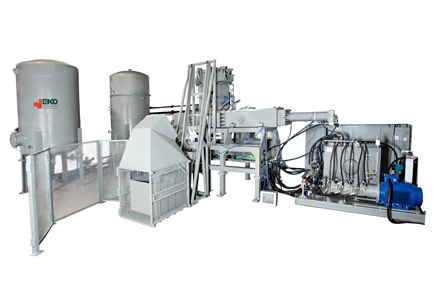The HazPak is capable of recycling up to 6,000 pressurized cans per hour. The cans can be full, partially full, or empty and can be loaded into the HazPak within the same batch. Once a bin of aerosols have been processed, the user is left with three recyclable forms: metal briquettes (the cans), liquefied petroleum gas (the propellant), and liquid waste (the product). These three end forms are stored separately and can be easily transported for re-use.
The process begins when the operator adds the bin of aerosol cans to the skip hoist. Depending on the size and shape of the aerosol cans, the bin will contain 750-1,000 cans. Once the bin is secured in the skip hoist, the operator can close the safety gate and walk to the control screen. From here, the operator sets the machine in motion while monitoring its status in realtime. By pressing the start button, the skip hoist raises the bin and feeds the aerosol cans into the hopper. Once the bin is emptied, the hopper lid will automatically close and seal off any additional oxygen from entering the compaction space.
Nitrogen is inerted into the compaction space to lower the oxygen level below 1%, eliminating any chance of explosion. Once optimal processing conditions are met and a vacuum has been established, compaction begins. The cans are crushed by a hydraulic cylinder shaping them into metal bricks, increasing in size with each stroke of the cylinder. While the cans are being crushed, any remaining liquids and gases inside the cans are released and sent to a tank under the Central Processing Unit. Using MacLean’s special process of gas compression, heating and vaporization, the liquids & gases are sent to separate storage tanks for future reuse. Once this process is completed, the metal bricks can be collected from the brick receiver area and a new bin of aerosols can be added to the skip hoist.
Throughout the process the operator can visually monitor the operation in real time and modify the operation using the touch screen controls on the LCD display. Safety and performance are key factors in the HazPak system. The HazPak is intrinsically safe through mechanical interlocks to prevent any escape of the propellant or liquid into the atmosphere. Safety sensors specifically designed to work in explosive atmospheres are located at strategic positions inside the HazPak and provide continuous monitoring information. It allows the operator to intervene, to move the stages, to open or close the gate and to obtain diagnostic information.

